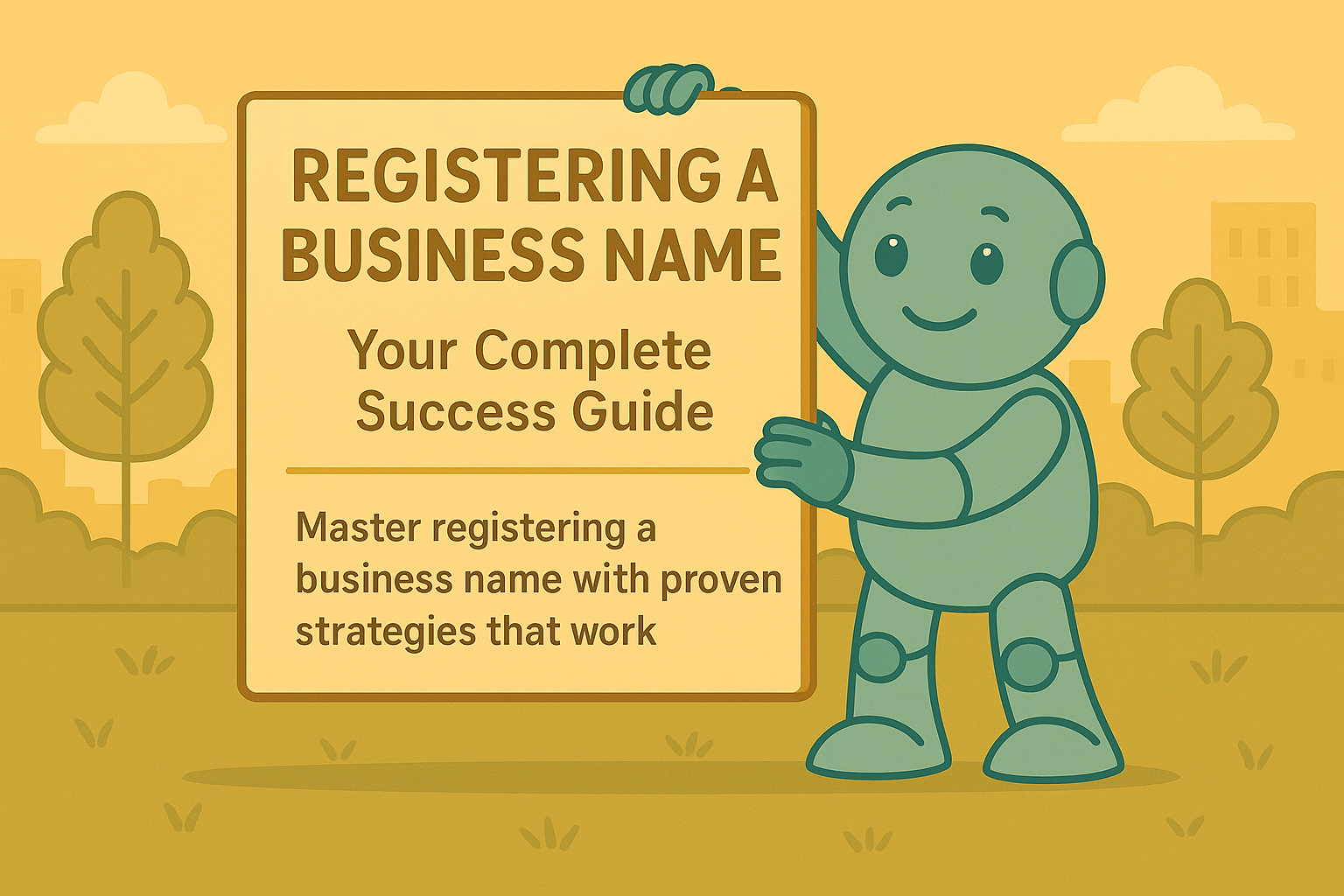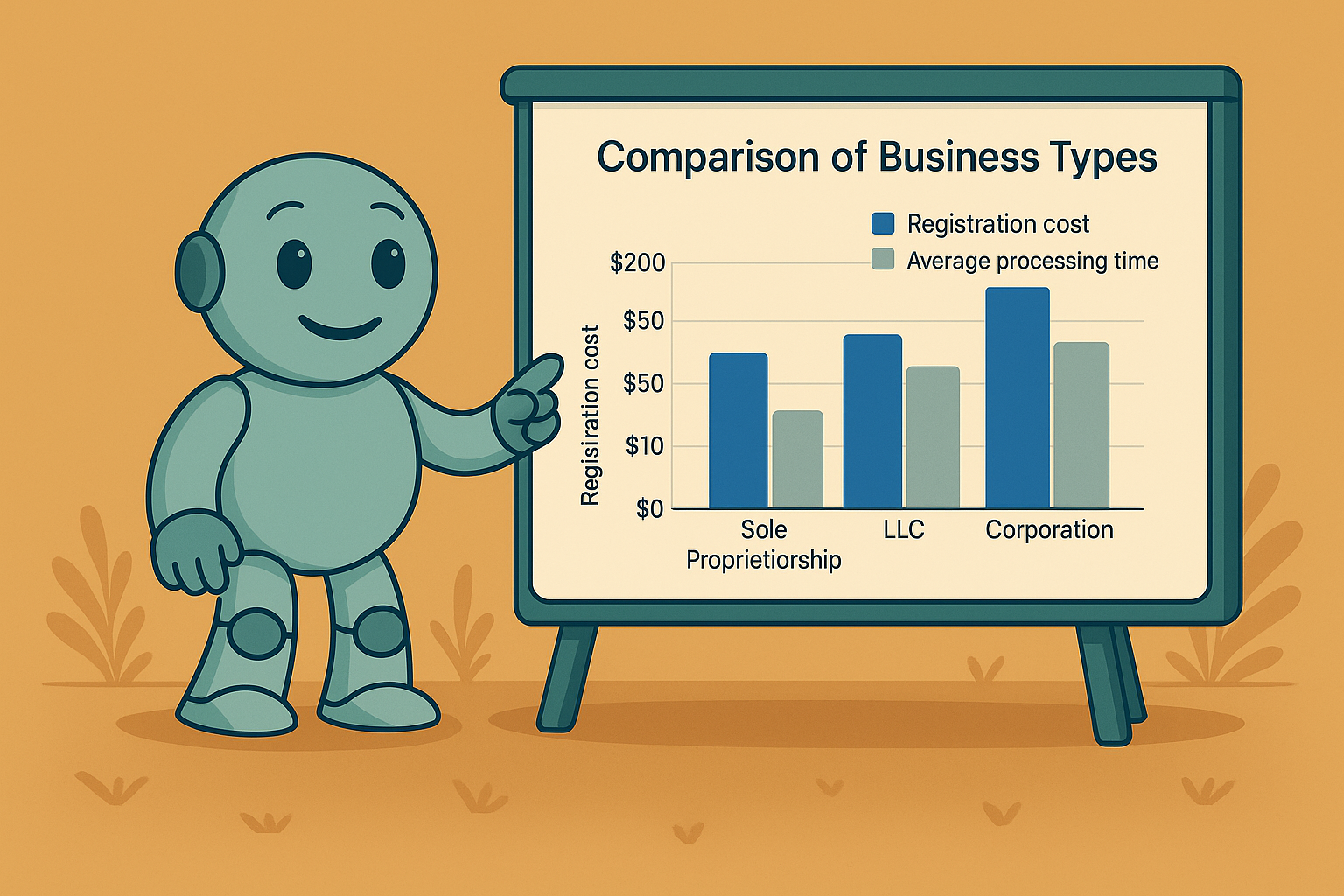Registering A Business Name: Your Complete Success Guide
Understanding What You're Really Getting Into

Registering a business name is a foundational step, not just a formality. It's integral to establishing your brand and protecting your business. Many guides oversimplify the process, leaving entrepreneurs unsure of the implications. This section clarifies the nuances of registration, drawing on insights from seasoned business owners.
What Registering a Business Name Actually Protects
Registering a business name offers several key protections. It typically prevents others in your jurisdiction from using the same, or a similar, name. This safeguards your brand identity, reducing the risk of customer confusion and legal battles. Registration can also provide a stronger legal basis for action against trademark infringement.
However, registration alone isn't a foolproof shield. It's often just the first step in a broader brand protection strategy, especially for businesses with national or international aspirations.
Business Name vs. Trade Name vs. Company Registration
The terminology surrounding business names can be a source of confusion. A business name is simply the name your business operates under. A trade name, sometimes called a "doing business as" (DBA) name, is used when operating under a name different from your legal business name. Company registration, on the other hand, is the formal legal process of establishing your business structure with the appropriate authorities.
Understanding these distinctions is essential for choosing the right registration path. The wrong structure upfront can lead to costly changes down the line, so careful planning is key.
Business Structure and Documentation
Your chosen business structure (sole proprietorship, LLC, corporation, etc.) significantly influences the registration process. Each structure has unique requirements and legal implications impacting liability and taxation. The necessary documentation also varies by location and business type.
While government websites offer general guidance, practical insights from experienced business owners can be invaluable. They can offer advice on streamlining the document gathering process and avoiding delays, saving you significant time and effort.
The registration process itself has evolved considerably. What once involved in-person visits and mountains of paperwork can now often be completed online in mere hours or days. In the UK, registration can take a few hours and cost as little as £12, while in Singapore it takes about a day for under $50 USD. For further insights, find more detailed statistics here. This demonstrates how technology and government reforms have made business registration more accessible.
Common Misconceptions
Several misconceptions cloud the business name registration process. One is that registration automatically grants trademark protection. While it provides some protection, it's distinct from trademark registration, which offers broader legal safeguards. Another misconception is that it guarantees online domain name or social media handle availability. These are separate processes and should be pursued alongside business name registration. Understanding these distinctions helps avoid future issues and ensures a smooth business launch.
Choosing A Name That Won't Haunt You Later
A strong business name is more than just a catchy phrase; it's a strategic asset. Conversely, a poorly chosen name can create significant challenges down the line. This section explores the key considerations for selecting a business name that will contribute to your success, not hinder it.
Trademark Conflicts: Avoiding Costly Legal Battles
Before settling on a name, conducting a thorough trademark search is paramount. This essential step helps identify potential conflicts with existing trademarks for similar goods or services. By addressing potential issues early, you can avoid costly legal disputes and the need for rebranding later on. Imagine investing in marketing and branding for "Fashion Forward," only to be forced to change it due to a pre-existing trademark. Such a scenario could be devastating, especially for a new business.
Domain Availability and Social Media Handles: Securing Your Online Presence
A consistent online presence is crucial in today's business environment. Securing a relevant domain name and matching social media handles are essential for building a cohesive brand identity. A memorable and readily available domain name simplifies online discovery for your customers. Furthermore, consistent branding across various social media platforms strengthens brand recognition and broadens your reach. Before registering your business name, verify its availability as a domain name and on relevant social media platforms. Explore alternatives if your preferred name is unavailable.
Testing Your Name: Validating Your Choice With Your Target Audience
Even after clearing legal and availability hurdles, ensure your chosen name resonates with your target audience. Gathering feedback through surveys, focus groups, or even informal conversations can reveal valuable insights into how potential customers perceive your name and its relevance to your industry. A name that seems ingenious to you might be confusing or unappealing to your target demographic. Consider resources like this guide on creating catchy company names for further guidance.
Balancing Creativity With Legal Requirements and Industry Restrictions
Balancing a creative and memorable name with legal and industry-specific regulations is vital. Some industries have strict naming conventions or prohibited terms. Researching these restrictions early prevents wasted effort and resources. For example, a financial services company using a name that implies a higher level of security than offered could attract regulatory scrutiny and legal complications. Thorough research is essential for navigating these complexities.
Supporting Your Growth Plans: Choosing a Name That Scales
Your business name should facilitate growth, not restrict it. A name too closely tied to a specific product or geographic location might hinder future expansion. Consider a bakery named "Hometown Breads" aiming for national distribution. The name might imply limited availability or a regional focus. A more versatile name allows for diversification and expansion into new markets and product lines. This proactive approach positions your business for long-term success.
The Registration Process That Actually Works

Forget generic checklists. This section outlines how successful entrepreneurs effectively register their business names. We'll break down each phase, offering realistic timelines and practical tips to avoid common pitfalls.
Navigating the Online Portals
The first step is knowing where to register. Different jurisdictions use different online portals. For example, in Pennsylvania, businesses register their names through the Department of State’s business filing services website. Knowing the correct platform for your location is crucial for a smooth registration.
Conducting Thorough Name Searches
After identifying the correct platform, a thorough name search is critical. This goes beyond simply checking availability on the registration portal. It also includes investigating potential trademark conflicts. This proactive approach prevents future legal issues and ensures your brand remains unique. Consider resources like NameRobot for comprehensive name verification. You might be interested in their article: How to master company name verification.
Gathering the Necessary Information
Each registration step requires specific information, such as business structure, contact details, and registered agent information. Having all necessary documentation prepared beforehand streamlines the process. This preparation prevents delays, much like packing everything needed before a road trip ensures a smoother journey.
Filling Out Applications Correctly
Even minor application errors can lead to rejection and significant delays. Double-checking every detail for accuracy and completeness is paramount. Having a second pair of eyes review your application can be invaluable for catching potential oversights.
Expedited Processing: When It's Worth the Cost
While standard processing suffices for many, some situations justify expedited processing. If facing a tight deadline, the extra fee can save valuable time. However, carefully weigh the costs against the benefits to make an informed decision.
Tracking Your Registration Status
Once submitted, actively track your application’s status. Most online portals provide tracking mechanisms, enabling you to monitor progress and address any potential issues promptly. This proactive approach ensures you're aware of any roadblocks and can take corrective action quickly. Securing your business name is a significant investment. Staying informed throughout the registration process is essential for success.
What It Really Costs And How Long It Takes
Budgeting for business name registration involves more than just the initial fee. Hidden expenses can surprise entrepreneurs, so understanding the full cost is vital for accurate financial planning. This section breaks down the various expenses and processing times involved.
Understanding The Fees
The most apparent cost is the registration fee, which varies depending on your business structure and location. For example, in Pennsylvania, registering a sole proprietorship costs $70, while forming an LLC costs $125. Furthermore, you might encounter name reservation fees if you want to secure your business name before officially registering. Expedited processing, while offering convenience, also carries an additional fee.
To illustrate the variations in costs and processing times across different jurisdictions, let's take a look at the table below:
Business Name Registration Costs And Processing Times By Country
| Country | Registration Cost | Processing Time | Online Available | Annual Fees |
|---|---|---|---|---|
| United States (Pennsylvania) | $70 (Sole Proprietorship), $125 (LLC) | Varies (Days to Weeks) | Yes | Varies |
| Canada (Ontario) | CAD $60 | 1-2 Business Days | Yes | CAD $60 |
| United Kingdom | £12 | 24 Hours | Yes | N/A |
| Australia | AUD $37 | 1 Business Day | Yes | AUD $37 |
This table provides a general overview and specific costs may vary.
As shown in the table, costs and processing times can differ significantly depending on the country. It's crucial to research the specific regulations and fees applicable to your chosen business jurisdiction.
Processing Time: From Days To Weeks
Processing times also fluctuate based on jurisdiction and application complexity. Some jurisdictions offer same-day processing for an added fee, but standard processing can take anywhere from a few days to several weeks. Seasonal variations can also influence processing times, with higher application volumes during certain periods. The infographic below visualizes average cost and processing time for three common business structures.

The infographic highlights the differences between sole proprietorships, partnerships, and corporations regarding registration cost and processing time. Sole proprietorships generally have the lowest registration cost and fastest processing time, while corporations typically have the highest cost and longest processing time.
Long-Term Costs: Renewals And Amendments
Beyond the initial registration, consider recurring costs. Most jurisdictions mandate annual renewals, and fees for amendments or corrections to your registration information may apply. These long-term costs are essential to consider for sustainable budget planning. Overlooking these can lead to unexpected expenses later on.
Business Structure Impact
Your chosen business structure influences your overall investment. Corporations, for instance, often entail higher registration fees and ongoing compliance costs compared to sole proprietorships or LLCs. Understanding these differences helps you make informed decisions aligned with your budget and long-term objectives.
Choosing The Right Strategy
Balancing cost and time is crucial. Expedited processing offers faster turnaround, but comes at a premium. Analyze your needs and timeline to see if the added cost is justified. If launching a time-sensitive project, expedited processing might be worthwhile. However, for businesses with more flexible timelines, standard processing usually suffices. Read also: How to register a trademark. Understanding the diverse cost factors and processing times allows you to make strategic decisions that suit your budget and business goals, ensuring a smooth and efficient registration process, setting a solid foundation for your business.
Avoiding The Mistakes That Cost Time And Money

Registering a business name is a crucial step in launching a venture. However, missteps in this process can lead to costly consequences down the line. This section examines some common errors entrepreneurs make during business name registration, drawing on the experiences of others to help you avoid similar pitfalls. By learning from these mistakes, you can save yourself time, money, and future headaches.
Insufficient Trademark Research: A Recipe For Disaster
One of the most frequent errors is inadequate trademark research. Failing to thoroughly check for similar existing trademarks can result in legal challenges later on. Imagine launching a successful clothing line, only to discover your brand name is already trademarked by a larger company. This could lead to costly legal battles and forced rebranding, potentially jeopardizing your entire business. Before registering a business name, utilize robust trademark search tools like Trademarkly for a comprehensive search.
Limiting Your Business’s Future: The Problem With Restrictive Names
Choosing a name too narrowly focused on your current offerings can hinder future expansion. For example, if your business name is "Philadelphia Pet Supplies" and you decide to expand beyond Philadelphia, or beyond pet supplies, your name suddenly becomes a liability. This forces you to consider rebranding, an expensive and time-consuming process. Consider your long-term vision when registering a business name, opting for a more versatile name that allows for growth and diversification.
Application Errors: Small Mistakes, Big Delays
Even seemingly minor errors on your business name registration application can cause significant delays or even outright rejection. Incorrect addresses, missing information, or inconsistencies in your documentation can trigger automatic rejections, setting you back weeks or even months. Thoroughly review your application before submitting, ensuring accuracy and completeness in every detail. Having a colleague or advisor review your application can provide a fresh perspective and help catch potential errors you might have missed.
Securing Your Digital Assets: More Important Than You Think
Many entrepreneurs overlook the importance of securing matching digital assets. Failing to secure a corresponding domain name and social media handles can weaken your online presence and create confusion among customers. This fragmentation makes it harder for customers to find you and dilutes your brand identity. Before registering your business name, verify the availability of matching domain names and social media handles. If your desired name is taken, consider alternatives or variations that maintain brand consistency.
Recovery Strategies: When Things Go Wrong
Despite careful planning, problems can still arise. Perhaps your application is rejected, or you discover a trademark conflict after registration. Knowing what to do in these situations can minimize the damage. Contact the relevant authorities promptly to understand the reason for rejection and take corrective action. In case of trademark conflicts, consulting with a legal professional is crucial to assess your options and protect your business. Don’t panic, but take swift and decisive action to rectify the situation. Being prepared and proactive can mitigate the impact of these unexpected challenges, saving you valuable time and resources in the long run. By avoiding these common pitfalls and implementing proactive strategies, you can streamline the registration process, safeguard your business, and build a solid foundation for future success.
Where Business Registration Is Heading
The business registration landscape is constantly changing, creating both obstacles and new possibilities for entrepreneurs. This fluid environment, driven by technological advances and regulatory updates, requires a proactive strategy. Keeping up with the latest trends is key to utilizing the most efficient registration methods.
The Rise of Streamlined Processes
Governments around the world are increasingly embracing digital solutions to simplify business registration. Many now offer online portals where entrepreneurs can register business names quickly and efficiently, often completing the process in just a few hours. This shift to online registration eliminates cumbersome paperwork and significantly reduces processing times.
Furthermore, AI-powered name search tools like Namefruits are emerging, simplifying the process of identifying potential trademark conflicts and selecting available names. These tools analyze extensive databases of existing business names and trademarks, offering valuable insights for entrepreneurs.
International Harmonization and Transparency
International agreements are playing a vital role in aligning registration processes across different countries. These agreements aim to streamline cross-border business operations by simplifying requirements and fostering greater transparency. Some agreements facilitate the recognition of business registrations across multiple jurisdictions, reducing the administrative burden for international businesses.
This increased transparency also affects how businesses operate, with some jurisdictions requiring greater disclosure of ownership and financial information. This movement towards greater transparency is prompting changes in regulatory frameworks, placing a greater emphasis on ethical business practices and corporate accountability.
Adapting to Change: A Proactive Approach
This ever-evolving landscape offers significant advantages for businesses. By understanding these trends, entrepreneurs can make informed decisions about registering a business name, selecting strategies that align with their objectives and current best practices. This proactive approach is crucial for navigating the complexities of business registration and capitalizing on emerging opportunities.
Staying informed about these trends allows businesses to anticipate and adapt to future changes. Globally, the number of registered businesses has grown significantly, reflecting this trend. By 2023, approximately 359 million companies were operating worldwide, up from 328 million in 2020. This represents an average annual increase of about 10 million new businesses, demonstrating the rapid expansion of the business landscape. Explore this topic further. This growth underscores the importance of efficient and readily available registration processes.
Embracing the Future of Business Registration
As technology continues to progress and regulations adapt, the future of business registration promises to be even more efficient and accessible. By embracing these changes and adopting a forward-thinking mindset, entrepreneurs can position their businesses for success in an increasingly competitive global market. This includes utilizing new tools and technologies, staying informed about regulatory updates, and proactively adjusting their registration strategies.
What Happens After You Hit Submit
Registering your business name is a significant milestone. However, it's not the finish line; it's more like the starting block. Many new business owners mistakenly believe registration is the final step. In reality, it's just the beginning. This section outlines the crucial post-registration steps you'll need to take to ensure long-term success.
Essential Post-Registration Tasks
After your business name registration is approved, you'll have several tasks that require immediate attention. These steps are critical for legally operating your business and maintaining ongoing compliance.
-
Obtain Necessary Licenses and Permits: Depending on your industry and location, you might need specific licenses and permits. These could include a sales tax license, professional licenses, or industry-specific permits. For example, a restaurant needs a food handler's permit, while a construction company requires building permits.
-
Establish a Business Bank Account: Separating your personal and business finances is essential for financial clarity and legal protection. A dedicated business bank account simplifies accounting, protects personal assets, and enhances your professional image.
-
Understand Ongoing Compliance Obligations: Registering your business name comes with ongoing compliance requirements, such as annual reports and renewals. Staying informed about these obligations helps you avoid penalties and maintains your registration in good standing. For example, Pennsylvania requires annual reports, and failure to file can result in administrative dissolution.
These post-registration tasks are not simply formalities; they are foundational elements for building a legitimate and thriving business.
To help you stay organized, we've created a checklist summarizing the key tasks and deadlines:
| Essential Post-Registration Checklist | Task | Priority Level | Typical Timeframe | Required Documents |
|---|---|---|---|---|
| Obtain Necessary Licenses and Permits | High | Varies by jurisdiction | Varies by license/permit | Varies by license/permit |
| Establish a Business Bank Account | High | 1-2 weeks | Business registration documents, personal identification | Varies by bank |
| Understand Ongoing Compliance Obligations | High | Ongoing | Varies by jurisdiction | Varies by jurisdiction |
| Trademark Protection (Optional) | Medium | 6-12 months | Trademark application, supporting documentation | Varies by jurisdiction |
This checklist offers a starting point for managing your post-registration responsibilities. Remember to research the specific requirements for your location and industry.
Protecting Your Business Name Long-Term
Beyond the immediate post-registration steps, consider strategies for protecting your business name in the long term.
-
Trademark Protection: Registering your business name provides some protection, but trademark registration offers broader legal safeguards against infringement. This becomes particularly important if you plan to expand nationally or internationally. A trademark is like an insurance policy for your brand name.
-
Maintain Accurate Records: Keep meticulous records of your registration documents, licenses, permits, and other relevant paperwork. Organized record-keeping simplifies future renewals, helps you meet compliance requirements, and prepares you for any potential legal issues. For example, having readily available documentation speeds up the license and permit renewal process.
By taking these proactive steps, you protect your brand and contribute to its long-term viability.
Staying Organized for Success
Effective organization is the cornerstone of meeting deadlines and avoiding penalties. Consider implementing these strategies:
-
Create a Post-Registration Checklist: Develop a comprehensive checklist outlining all required tasks, including deadlines and necessary documents. This creates a clear roadmap and ensures no crucial steps are missed.
-
Set Reminders: Use calendar reminders or task management software to track deadlines for renewals, reports, and other compliance obligations. This proactive approach helps you avoid late filings and potential penalties.
These organizational systems are crucial for effectively managing your business and protecting its status. Registering your business name is a significant step, but it's just the first of many. By focusing on post-registration tasks and long-term protection strategies, you'll build a solid foundation for sustainable growth and success. Use NameRobot's tools to manage your business name and trademarks effectively.















